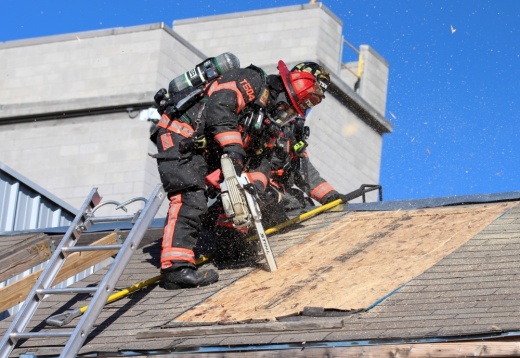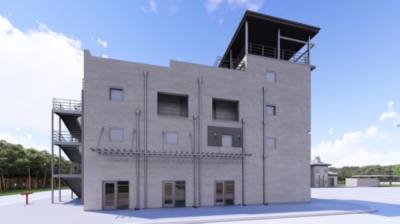Lewisville is funding more than half of the facility’s $6.9 million cost. Highland Village and Flower Mound will provide the rest, with that money coming from different sources in those cities.
Highland Village Fire Chief Jason Collier said the facility will benefit each of the three departments.
“The facility not only allows us to train on our basic skills but also specialty skills which improves the quality of our departments and provides a higher level of service to our citizens,” he said.
Two-minute impact
The new center will help fire departments meet training requirements from the Insurance Services Office—a national organization whose ratings are used by insurance companies for setting rates.
The organization’s ratings played a role in the desire to build a facility, as these ratings can have a far-reaching effect on business recruitment and resident relocation.
Flower Mound Fire Chief Paul Henley said the departments are aiming for the organization’s highest rating. The better the rating, the better the commercial and residential rates can be.
“ISO ratings can advise the community on a local fire department’s fire protection capabilities,” he said, adding that firefighters' training hours figure into the rating.
Firefighters must have 18 hours of facilities training per year. The facility must be on a certain acreage, have a tower and be able to have live fire burns, Henley said. Some programs can allow local officials and leaders to experience live fire exercises, vehicle extrications and EMS scenarios, said John Riddle, president of the Texas State Association of Fire Fighters.
The details
Collier said training at the new facility will primarily include simulation of a number of situations, such as household fires and commercial strip center fires.
The commercial-style building will have three interior floors and an open-deck fourth level with an upper canopy for rope rescue training. The second building will be a two-story, single-family residence with an attached garage.
Zooming out
Riddle said cost savings are one reason fire departments use these kinds of training facilities.
“Over the long term, the training facilities help localize or customize fire training, reduce training costs and raise awareness of the fire service,” he said. “[These] facilities also help local elected officials and other community leaders better understand the fire service and make more informed decisions about the fire service.”
The facility’s architect highlighted the building’s versatility.
“It has been great to see how three fire departments and three cities have been able to come together to ... bring this state-of-the-art training facility to reality,” said Justin Myers, partner with Martinez Architects.
Some fire training facilities are affiliated with community colleges and universities while others are built and managed by cities, counties and emergency services districts.
Looking ahead
Sharing a training facility is expected to benefit the three departments—which have tended to calls together before—on future collaborations. The facility—with simulated residential and commercial buildings that will be used for training—could open in the next 18 months, Henley said.






